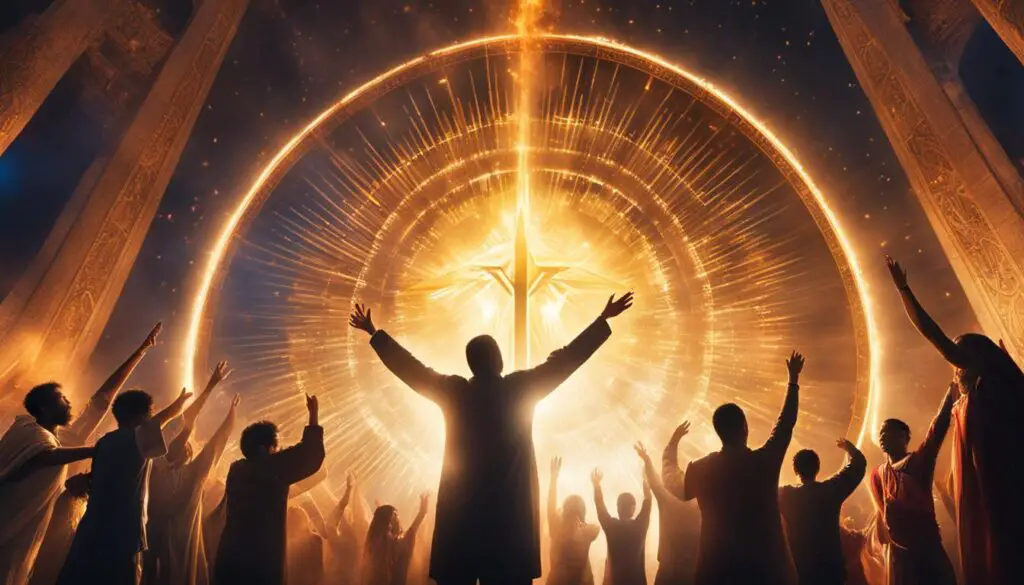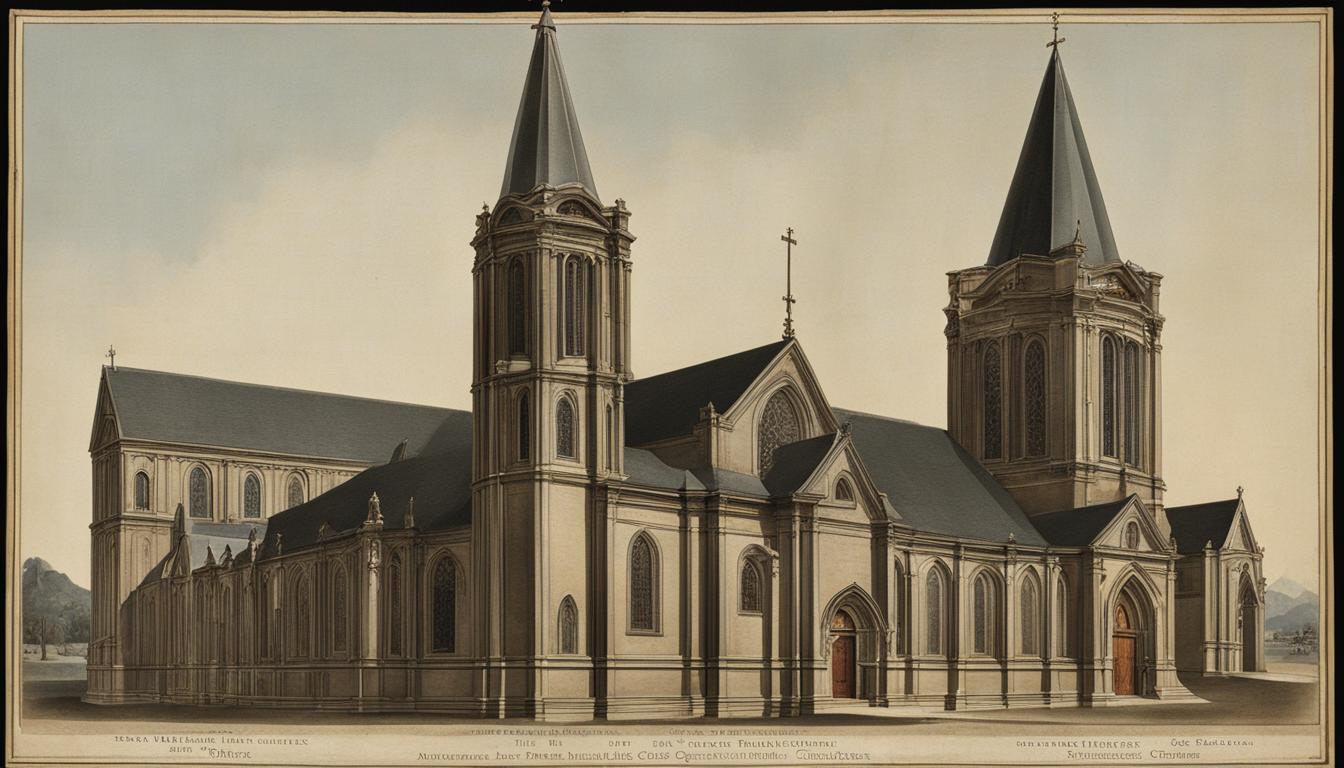The history of Christianity is full of twists and turns, from its earliest beginnings as a group of outcasts to the modern-day church. This comprehensive guide will take you through the key events and developments in modern church history, starting from the Protestant Reformation and continuing to the present day. We will explore the historical development of the church, including important movements, influential figures, and significant milestones. Get ready to dive deep into the fascinating and complex world of modern church history.
Key Takeaways:
- Modern church history is a tapestry of key events, influential figures, and significant movements.
- The Protestant Reformation was a pivotal moment that led to the formation of Protestant denominations.
- The Counter-Reformation was the Catholic Church’s response to the Protestant Reformation.
- The Great Awakenings played a significant role in the growth of evangelicalism.
- The Pentecostal Movement emphasized the experience of the Holy Spirit.
The Protestant Reformation: A Turning Point in Church History
The Protestant Reformation, led by Martin Luther, was a religious revolution that brought significant changes to the Christian Church. Luther’s Ninety-Five Theses, which criticized the corrupt practices of the Catholic Church, ignited a wave of reform and challenged the established authority. This movement marked a turning point in church history, as it led to the emergence of Protestant denominations and transformed the religious landscape.
One of the key aspects of the Protestant Reformation was its emphasis on individual interpretation of Scripture and the belief in justification by faith alone. Luther’s teachings brought about widespread debate and discussion, sparking a movement that gained momentum across Europe. As more people joined the cause, the Catholic Church faced a significant challenge to its authority and teachings.
The impact of the Protestant Reformation can still be felt today. It not only resulted in the formation of new Christian denominations but also inspired changes in various aspects of society. The Reformation encouraged the development of education for all, as the reformers sought to make the Bible accessible to the common people. It also played a role in shaping religious freedom and individual rights, as people began to question and challenge traditional religious practices.
Key Aspects of the Protestant Reformation
- Martin Luther’s Ninety-Five Theses
- Emphasis on individual interpretation of Scripture
- Belief in justification by faith alone
- Formation of Protestant denominations
- Development of education for all
- Influence on religious freedom and individual rights
“I cannot and will not recant anything, for to go against conscience is neither right nor safe. Here I stand, I can do no other, so help me God. Amen.”
– Martin Luther
The Counter-Reformation: A Response to Protestantism
The Counter-Reformation was a significant movement initiated by the Catholic Church in response to the Protestant Reformation. Its aim was to address the criticisms raised by the reformers and reaffirm Catholic doctrine and practice. One of the key events during this period was the Council of Trent, which played a pivotal role in shaping the course of the Counter-Reformation.
The Council of Trent was convened by Pope Paul III in 1545 and lasted for several years. It was a series of meetings and discussions among Catholic leaders and theologians. The council addressed various issues that had been raised by the Protestant reformers, including matters of doctrine, the sacraments, and the role of the clergy. The Council of Trent sought to clarify Catholic teachings and strengthen the authority of the Church.
One of the outcomes of the Council of Trent was the establishment of seminaries to train priests in Catholic doctrine and ensure their adherence to the teachings of the Church. This helped to strengthen the Catholic clergy and ensure their ability to counter the influence of Protestant ideas. Additionally, the council reaffirmed the importance of the sacraments and the role of the Church in salvation, rejecting the Protestant doctrine of justification by faith alone.
The Counter-Reformation had a lasting impact on the Catholic Church and on the development of modern Christianity. It revitalized and reformed many aspects of Catholic practice, including the liturgy, religious art, and education. The Counter-Reformation also led to the formation of new religious orders, such as the Society of Jesus (Jesuits), whose members played a crucial role in spreading Catholicism around the world. Overall, the Counter-Reformation was a response to the challenges posed by the Protestant Reformation and played a significant role in shaping the course of modern church history.

Council of Trent: Key Decisions and Outcomes
| Topic | Decisions |
|---|---|
| Doctrine | The Council of Trent affirmed the authority of tradition alongside scripture, rejecting the Protestant doctrine of sola scriptura. It clarified Catholic teachings on original sin, justification, and the sacraments. |
| The Sacraments | The council reaffirmed the seven sacraments of the Catholic Church, rejecting the Protestant belief in only two sacraments. It emphasized the importance of the sacraments in the process of salvation. |
| Education and Clergy | The Council of Trent established seminaries to provide proper education and training for Catholic priests. It also called for reforms in the behavior and conduct of the clergy. |
| Liturgy and Worship | The council standardized the liturgy and reaffirmed the importance of traditional Catholic practices and ceremonies. It also addressed issues related to religious art and iconography. |
The Great Awakenings: Revivals and Renewals
The Great Awakenings were a series of religious revivals that occurred during the 18th and 19th centuries. These movements were marked by a renewed interest in Christianity and a significant impact on the development of evangelicalism. The Great Awakenings brought about a spiritual awakening and ignited a fervor for religious devotion among believers.
During this time, powerful preachers like George Whitefield and Jonathan Edwards emerged as influential leaders, captivating audiences with their passionate sermons. Their messages emphasized personal conversion, salvation through faith, and the importance of a deep relationship with God. Thousands were moved to tears, repentance, and commitment to a life dedicated to serving Christ.
The Great Awakenings had a profound impact on American society, leading to the formation of new churches and missionary societies. The revivals also played a significant role in shaping cultural and political movements like the abolition of slavery and the fight for social justice. These awakenings sparked a renewed emphasis on spirituality and evangelicalism, laying the foundation for the expression of faith that continues to resonate in contemporary Christianity.
The Impact of the Great Awakenings
- The Great Awakenings brought about a renewed interest in Christianity and a focus on personal conversion and spiritual experience.
- These revivals led to the formation of new churches and missionary societies, expanding the reach of Christianity across the American colonies and beyond.
- The movement influenced cultural and political movements, sparking social reform efforts, and advocating for social justice.
- The Great Awakenings laid the foundation for evangelicalism and emphasized the importance of a personal relationship with God, which continues to shape modern Christianity.
The Great Awakenings were a transformative period in modern church history, ushering in a wave of religious fervor and shaping the trajectory of Christianity. These revivals not only brought about personal transformations but also had a lasting impact on society and culture. As we examine the history of the Great Awakenings, we gain insight into the power of revival and the enduring influence of passionate faith.
Table: Key Characteristics of the Great Awakenings
| Characteristics | Impact |
|---|---|
| Renewed emphasis on personal conversion and salvation through faith | Transformed individuals’ lives and sparked spiritual awakening |
| Focus on powerful preaching and emotional responses | Captured the attention and hearts of thousands of believers |
| Formation of new churches and missionary societies | Expanded the reach of Christianity and led to the spread of the Gospel |
| Influence on cultural and political movements | Contributed to social reform efforts and advocacy for justice |
| Shaped the development of evangelicalism | Emphasized the importance of personal relationship with God |
The Pentecostal Movement: A Renewed Emphasis on the Holy Spirit
The Pentecostal Movement, which emerged in the early 20th century, has had a profound impact on modern Christianity. With its charismatic worship style and emphasis on the Holy Spirit, this movement has attracted millions of believers worldwide. Pentecostal churches are known for their enthusiastic worship, speaking in tongues, and belief in the charismatic gifts of the Spirit. This emphasis on the Holy Spirit sets Pentecostalism apart from traditional Christian denominations and has led to the rise of charismatic and Spirit-filled churches.
The origins of the Pentecostal Movement can be traced back to the Azusa Street Revival in Los Angeles, California, which began in 1906. Led by William J. Seymour, this revival sparked a spiritual awakening that attracted people from different races and socio-economic backgrounds. The participants experienced an outpouring of the Holy Spirit and manifested spiritual gifts such as speaking in tongues and healing. The Azusa Street Revival became the catalyst for the spread of Pentecostalism across the United States and eventually around the world.
The Pentecostal Movement, with its focus on the Holy Spirit and spiritual gifts, has transformed the way many Christians worship and experience their faith. It has brought a renewed passion and an expectation of the supernatural into the church.
The impact of the Pentecostal Movement cannot be overstated. It has influenced not only theology and worship styles but also social and cultural dynamics within Christianity. Today, Pentecostal and charismatic Christianity is one of the fastest-growing religious movements in the world, with millions of adherents. The movement’s emphasis on personal spiritual experiences and direct encounters with the Holy Spirit resonates with many believers who seek a deeper, more vibrant faith.
| Key Characteristics of the Pentecostal Movement |
|---|
| 1. Emphasis on the Holy Spirit and spiritual gifts |
| 2. Speaking in tongues as evidence of baptism in the Holy Spirit |
| 3. Vibrant and expressive worship styles |
| 4. Belief in divine healing and miracles |
| 5. Strong sense of community and fellowship |
The Growth of Pentecostalism Worldwide
Pentecostalism has spread across the globe, attracting followers from a wide range of cultures and backgrounds. The movement has experienced significant growth in Latin America, Africa, and Asia, with large Pentecostal communities in countries such as Brazil, Nigeria, and South Korea. The appeal of Pentecostalism lies in its ability to provide a personal connection with God and a sense of empowerment for believers.
The Pentecostal Movement continues to evolve and adapt to the changing landscape of modern Christianity. It has influenced other denominations and brought new energy and enthusiasm to the broader church. Whether through its worship styles, emphasis on spiritual gifts, or focus on personal encounters with the Holy Spirit, Pentecostalism has made a lasting impact on the practice and understanding of faith in the 21st century.

Modern Missionaries: Spreading the Gospel Across the Globe
Modern missionaries have played a crucial role in spreading the Gospel to every corner of the globe. Their unwavering commitment to sharing the message of Jesus Christ has shaped the landscape of global Christianity. From the early pioneers who ventured into unknown territories to the modern-day efforts to reach unreached people groups, missionaries have been catalysts for change, bringing hope and faith to those in need.

One of the prominent figures in modern missionary history is Hudson Taylor. As a pioneering missionary to China in the 19th century, Taylor established the China Inland Mission (now known as OMF International) and devoted his life to spreading the Gospel in a culturally sensitive manner. Through his tireless efforts, the Christian faith took root in China, leading to the growth of the Chinese church.
“The Great Commission is not an option to be considered; it is a command to be obeyed.” – Hudson Taylor
Amy Carmichael is another missionary who left a lasting impact on the world. She dedicated her life to rescuing young girls from temple prostitution in India and founded the Dohnavur Fellowship. Through her selfless love and sacrificial service, Carmichael transformed the lives of many and brought the message of God’s redeeming love to the marginalized.
The Impact of Mission Work
The work of modern missionaries has not only influenced individual lives but has also shaped the course of global Christianity. Missionary efforts have led to the establishment of churches, the translation of the Bible into various languages, and the growth of vibrant Christian communities in places where the Gospel was once unknown.
Furthermore, mission work has served as a catalyst for social and humanitarian initiatives. Missionaries have been at the forefront of providing education, healthcare, and community development, addressing the holistic needs of individuals and communities. Through their dedication and love, missionaries have brought light and hope to some of the darkest corners of the world.
Mission Work in the Modern Era
In today’s interconnected world, mission work continues to evolve and adapt to changing contexts. Missionaries utilize diverse strategies, including short-term missions, community engagement, and digital outreach, to meet the unique challenges and opportunities of the modern era.
The call to mission work remains as relevant as ever, with a focus on reaching the unreached, demonstrating the love of Christ, and empowering local believers to become agents of transformation in their own communities. Through collaboration and partnership with churches, organizations, and individuals, modern missionaries are making a difference and shaping the future of global Christianity.
| Modern Missionaries | Country/Region | Impact |
|---|---|---|
| Hudson Taylor | China | Established the China Inland Mission and laid the foundation for the Chinese church |
| Amy Carmichael | India | Rescued girls from temple prostitution and founded the Dohnavur Fellowship |
| William Carey | India | Translated the Bible into multiple Indian languages and laid the groundwork for modern missions |
| Elisabeth Elliot | Ecuador | Spread the Gospel to remote indigenous communities and impacted generations through her writings |
| David Livingstone | Africa | Explored uncharted territories in Africa and highlighted the need for Christian missions |
The Impact of Ecumenism: Seeking Unity Among Christian Churches
Ecumenism plays a crucial role in modern church history as it fosters unity among different Christian traditions and denominations. The movement seeks to promote understanding, cooperation, and dialogue among churches, with the ultimate goal of bridging the gaps between Christian traditions. Through ecumenical councils and organizations like the World Council of Churches, interdenominational unity is actively promoted and pursued.
One of the key aims of ecumenism is to overcome the divisions that have historically separated Christian communities. By creating opportunities for interdenominational cooperation, ecumenism encourages Christians of different backgrounds to come together, share their faith, and work towards common goals. Through shared worship, dialogue, and joint initiatives, Christians can build relationships and strengthen their understanding of one another.
The emphasis on Christian unity extends beyond theological differences. Ecumenism also seeks to address social justice issues and promote advocacy for peace, human rights, and environmental stewardship. By uniting in these common causes, Christians can make a greater impact and reflect the Gospel’s message of love, compassion, and justice in a world that is often divided.
The Ongoing Efforts for Christian Unity
Despite the progress made in promoting Christian unity, there are still challenges and obstacles to overcome. Differences in theology, worship practices, and governance structures can hinder the process of ecumenical cooperation. However, through continued dialogue and a commitment to understanding, Christians are working towards greater unity and reconciliation.
The impact of ecumenism can be seen in various initiatives and partnerships between different Christian traditions. These collaborative efforts include joint worship services, shared community projects, and theological dialogues that seek to find common ground and deepen understanding. By focusing on shared beliefs and values, Christians can build bridges and foster a spirit of unity that extends beyond denominational boundaries.
In conclusion, ecumenism plays a vital role in modern church history by seeking unity among Christian churches. Through the promotion of understanding, cooperation, and dialogue, ecumenism bridges the gaps between Christian traditions and fosters a spirit of unity. While there are still challenges to overcome, ongoing efforts for Christian unity continue to make a significant impact in the church and society as a whole.

The Evolution of Church Leadership: Adapting to Changing Times
The role of church leadership has evolved over time in response to changing societal and cultural dynamics. In the modern era, churches have had to adapt to meet the needs of a rapidly changing world. Traditional hierarchical structures are giving way to more participatory and inclusive models of leadership.
One of the key aspects of the evolving church leadership is the move towards shared leadership and team-based approaches. Instead of relying solely on a single pastor or minister, churches are embracing a collaborative leadership style that encourages input from multiple members of the congregation. This model fosters a sense of ownership and shared responsibility among the church community, and allows for a more diverse range of perspectives and gifts to be utilized.
Another important aspect of the evolving church leadership is the emphasis on equipping and empowering the laity. Churches are recognizing the importance of developing and nurturing the leadership potential within their congregations. This involves providing training and mentorship opportunities for individuals to grow in their faith and leadership skills. By empowering the laity, churches are able to tap into a wider pool of talent and expertise, and create a sense of ownership and investment among the members.
| Traditional Hierarchical Model | Shared Leadership Model |
|---|---|
| Top-down decision-making | Collaborative decision-making |
| Centralized authority | Decentralized authority |
| Emphasis on clergy | Emphasis on laity |
This evolution in church leadership is not without its challenges. It requires a shift in mindset and a willingness to let go of traditional power dynamics. It also requires intentional efforts to develop and support emerging leaders within the congregation. However, the benefits of this evolving model are clear. It enables churches to adapt to the changing needs of the community, fosters a greater sense of ownership and empowerment among the members, and allows for a more diverse and inclusive expression of leadership.
As the world continues to evolve, it is essential for churches to embrace this evolution in leadership and continue to adapt to the changing times. By doing so, they can effectively fulfill their mission of spreading the message of love, hope, and transformation in a world that is in constant flux.
The Intersection of Faith and Culture: Navigating a Changing World
The church has always been deeply intertwined with the culture in which it exists. Throughout modern church history, faith and culture have influenced and shaped each other in profound ways. As society undergoes continuous cultural shifts, the church must navigate these changes while staying true to its core beliefs and principles.
One significant cultural shift that has impacted the church is the changing social norms. Attitudes towards marriage, gender roles, and sexuality have evolved, challenging traditional beliefs and forcing the church to engage in conversations and re-evaluate its teachings. The intersection of faith and culture in these areas has sparked debates and divisions within the church.
Advancements in technology have also presented new challenges and opportunities for the church. The rise of social media and digital communication platforms has transformed the way people interact and consume information. The church has had to adapt to these changes, using technology as a powerful tool to reach and connect with individuals in innovative ways.
“The church must navigate the complexities of a changing world while remaining faithful to its mission and values.”
The Church’s Response
In response to these cultural shifts, the church has adopted various approaches. Some churches have taken a more progressive stance, embracing inclusivity and actively promoting social justice causes. Others have chosen to maintain a more conservative outlook, preserving traditional beliefs and values.
There is also a growing movement towards cultural engagement, with churches seeking to understand and address the needs of their communities. This includes initiatives that provide support and resources for individuals and families, tackling issues such as poverty, addiction, and mental health. By actively engaging with the culture, the church aims to make a positive impact and remain relevant in a rapidly changing world.
Ultimately, the intersection of faith and culture requires the church to navigate complex and often divisive issues. It calls for dialogue, empathy, and a willingness to listen and learn from different perspectives. As the church continues to adapt and evolve, it must strive to strike a balance between staying rooted in its beliefs and actively engaging with the world around it.

Table: Cultural Shifts and the Church’s Response
| Cultural Shift | Church’s Response |
|---|---|
| Changing social norms | Engaging in conversations, re-evaluating teachings, and promoting inclusivity or maintaining traditional beliefs and values. |
| Advancements in technology | Using technology as a tool for outreach, connection, and spreading the message. |
| Cultural engagement | Addressing the needs of the community through initiatives that provide support and resources. |
The church’s response to cultural shifts is multifaceted and varies across different denominations and individual congregations. It reflects the diverse perspectives and approaches within the body of Christ as it seeks to navigate a changing world while remaining faithful to its mission and values.
Conclusion
In conclusion, modern church history has witnessed significant developments and major transformations that have shaped the course of Christianity. From the Protestant Reformation to the present day, the church has navigated through a changing landscape, adapting to the challenges and opportunities of the world around it.
Throughout this comprehensive guide, we have explored key events, influential figures, and movements that have defined modern church history. We have delved into the religious revolution brought about by the Protestant Reformation and the Catholic Church’s response in the form of the Counter-Reformation. We have also examined the impact of the Great Awakenings, the Pentecostal Movement, and the work of modern missionaries in spreading the Gospel globally.
Moreover, we have studied the influence of ecumenism in seeking unity among Christian churches, the evolution of church leadership to meet changing times, and the dynamic relationship between faith and culture. By understanding these historical developments, we gain insights into the growth and relevance of Christianity in the modern era.
As we move forward, it is crucial to learn from the past and adapt to the ever-changing world. By acknowledging the major transformations in the church and embracing the challenges of the present, we can ensure that Christianity continues to thrive and make a positive impact on society.
FAQ
What is modern church history?
Modern church history refers to the period of time from the Protestant Reformation to the present day, encompassing key events, influential figures, and significant movements in Christianity.
What was the Protestant Reformation?
The Protestant Reformation was a religious revolution led by Martin Luther in the 16th century. It marked a breakaway from the Catholic Church and the formation of Protestant denominations.
What was the Counter-Reformation?
The Counter-Reformation was the Catholic Church’s response to the Protestant Reformation. It involved efforts to address criticisms raised by the reformers and reaffirm Catholic doctrine and practice.
What were the Great Awakenings?
The Great Awakenings were a series of religious revivals that took place in the 18th and 19th centuries. They sparked renewed interest in Christianity and played a significant role in the growth of evangelicalism.
What is the Pentecostal Movement?
The Pentecostal Movement emerged in the early 20th century and emphasizes the experience of the Holy Spirit. It is characterized by enthusiastic worship, speaking in tongues, and belief in the charismatic gifts of the Spirit.
What role have modern missionaries played in church history?
Modern missionaries have played a crucial role in spreading the Gospel to every corner of the globe. Their work has shaped the landscape of global Christianity and continues to reach unreached people groups.
What is ecumenism?
Ecumenism is the movement towards unity among different Christian traditions and denominations. It seeks to foster understanding, cooperation, and dialogue among churches for interdenominational unity.
How has church leadership evolved in modern church history?
Church leadership has adapted to changing societal and cultural dynamics. Traditional hierarchical structures have given way to more participatory and inclusive models, such as shared leadership and team-based approaches.
How does the church navigate the intersection of faith and culture?
The church has always been influenced by the prevailing culture and has, in turn, shaped it. Navigating the intersection of faith and culture involves understanding and responding to changing social norms and advancements in technology.
What are the major developments in modern church history?
Modern church history is marked by major transformations, from the Protestant Reformation to the rise of evangelicalism, the Pentecostal Movement, and ongoing efforts for Christian unity and mission work.
















